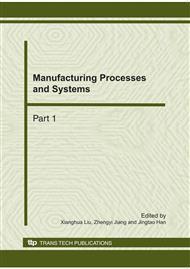[1]
N. Tsutsumi, T. Nakamura, T. Kiyotsuku: Copolymerization of aniline. Macromolecules 1960, 23: 761-764.
Google Scholar
[2]
M.T. Nguyen, P. Kasai, J.L. Miller, and A.F. Diaz: Synthesis and properties of novel water-soluble conducting polyaniline copolymers. Macromolecules 1994, 27: 3625-3631.
DOI: 10.1021/ma00091a026
Google Scholar
[3]
W.S. Huang, A.G. MacDiarmid: Optical properties of polyaniline. Polymer 1993, 34: 1833 -1845.
DOI: 10.1016/0032-3861(93)90424-9
Google Scholar
[4]
L.Z. Zheng, L.Y. Xiong, C.F. Liu, and L.H. Jin: Electrochemical synthesis of a novel sulfonated polyaniline and its electrochemical properties. European Polymer Journal 2006, 42: 2328-2333.
DOI: 10.1016/j.eurpolymj.2006.07.002
Google Scholar
[5]
M.R. Nabid, A.A. Entezami: Enzymatic synthesis and characterization of a water-soluble, conducting poly(o-toluidine). European Polymer Journal 2003, 39: 1169-1175.
DOI: 10.1016/s0014-3057(02)00379-8
Google Scholar
[6]
R. Keungarp, J.P. McEldoon, A.R. Pokora, W. Cyrus, and J.S. Dordick: Numerical and monte carlo simulations of phenolic polymerizations catalyzed by peroxidase. Biotechnology engineering 1993, 42: 807-814.
DOI: 10.1002/bit.260420704
Google Scholar
[7]
G.L. Yuan, N. Kuramoto, and S.J. Su: Template Synthesis of polyaniline in the presence of phosphomannan. Synthetic Metals 2002, 129: 173-178.
DOI: 10.1016/s0379-6779(02)00049-8
Google Scholar
[8]
C.H. Lim, Y.J. Yoo: Synthesis of ortho-directed polyaniline using horseradish peroxidase. Process biochemistry 2000, 36(3): 233-241(9).
DOI: 10.1016/s0032-9592(00)00193-x
Google Scholar
[9]
J. Sakurada, R. Sekiguchi, K. Sato, T. Hosoya: Kinetic and molecular orbital studies on the rate of oxidation of monosubstituted phenols and anilines by horseradish peroxidase compound II. Biochemistry 1990, 29(17): 4093-8.
DOI: 10.1021/bi00469a011
Google Scholar
[10]
W. Liu, J. Kumar, S. Tripathy, K.J. Senecal, L. Samuelson: Enzymatically synthesized conducting polyaniline. J Am Chem Soc 1999, 121: 71-78.
DOI: 10.1021/ja982270b
Google Scholar
[11]
R. Nagarajan, S. Tripathy, J. Kumar: An enzymatically synthesized conducting molecular complex of polyaniline and poly(vinyl phosphonic acid). Macromolecules 2000, 33(26): 9542-9547.
DOI: 10.1021/ma000954+
Google Scholar
[12]
E.T. Kang , K.G. Neoh, and K.L. Tan. Polyaniline: A polymer with many interesting intrinsic redox states. Progress in Polymer Science 1998, 23: 277-324.
DOI: 10.1016/s0079-6700(97)00030-0
Google Scholar
[13]
L.T. Cai, S.B. Yao, and S.M. Zhou: Improved conductivity and electrical properties of polyaniline in the presence of rare-earth cations and magnetic field. Synthetic Metals 1997, 88(3): 205-208.
DOI: 10.1016/s0379-6779(97)03851-4
Google Scholar
[14]
T.L.A. Campos, D.F. Kersting, and C.A. Ferreira: Chemical synthesis of polyaniline using sulphanilic acid as dopant agent into the reactional medium. Surface and Coatings Technology 1999, 122(1): 3-5.
DOI: 10.1016/s0257-8972(99)00399-0
Google Scholar
[15]
H.S.O. Chan, M.T.B. Teo, E. Khor, and C.N. Lim: Thermal analysis of conducting polymers part I Thermogravimetry of acid doped polyanilines. J Thermal Anal 1989, 35(3): 765-774.
DOI: 10.1007/bf02057231
Google Scholar
[16]
Y. Wei, K.F. Hsueh: Thermal analysis of chemically synthesized polyaniline and effects of thermal aging on conductivity. Journal of Polymer Science Part A: Polymer Chemistry 1989, 27(13): 4351-4363.
DOI: 10.1002/pola.1989.080271312
Google Scholar


